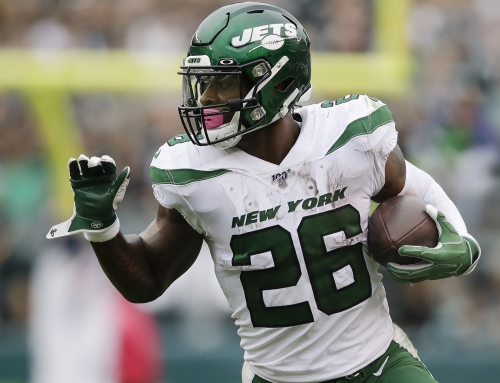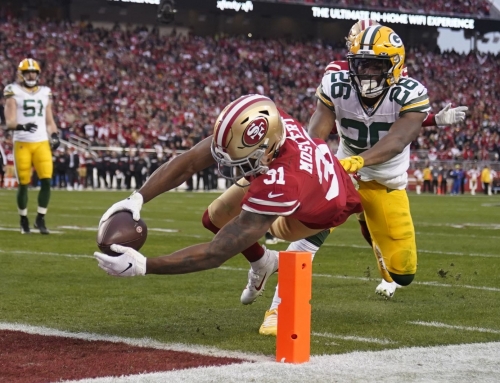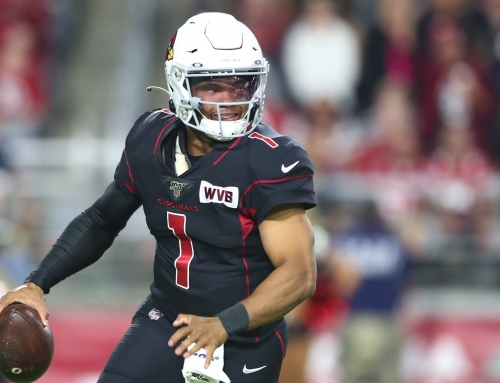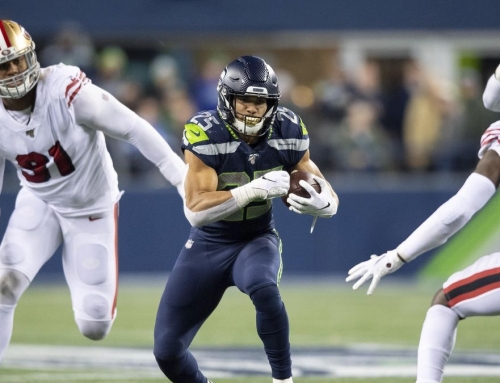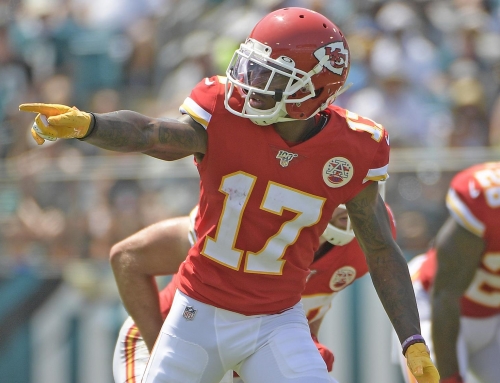Progressively more often in fantasy football, and specifically more in the little niche that we refer to as dynasty, we are subject to several different types of biases. These biases can be very difficult to break. Perhaps you find yourself unwilling to forget when a player was originally selected in the NFL Draft, or maybe you’re stuck believing that running backs retain little value because of a shorter shelf life. There are even those out there who still think Devin Funchess is good at football. However, one of the biggest biases people encounter in the dynasty community is ageism. Ageism is rampant ‘round these parts and it can difficult to look past. We all want to grab that stud wide receiver when he is 22 years old, setting the world on fire a la Odell Beckham Jr. in 2014. You can expect to roster players like Beckham Jr. for a solid ten years, anticipating their value to grow over time; that’s the dream. In search of that dream, however, too often we forget to look at the old reliables; those players whose lives have stretched past the dreaded 30-year-old mark, the mark when we expect them to decline immediately after opening kickoff; causing our seasons to be ruined and setting our dynasties back several years.
It doesn’t have to be that way, and I’m here to help. I’m here to tell you that it’s okay to draft the older players sometimes. It’s okay if you’re fielding a team with a few players over the age of 30. I’m certainly not suggesting that you should target these players exclusively, but there is plenty of value in the veteran player pool and that it’s not necessarily just for contenders. If you are building heavy through drafts this year, you may want to offset your roster with some players who are expected to perform at a high level for the next two to three years. This way, as your rookies and younger players develop, you will have the talent necessary to fill in positional gaps that you may have missed out on.
In this article, I’m going to highlight several players I think you should target either in startup drafts or as trade targets because you might be able to get them at a favorable value as a result of their age. I will also share how long I predict their shelf life to be and with which type of roster I think you should add them to. Additionally, given the current value that you can acquire these players for, they should help your team not just this year, but in the following years as well. Oh, and just one quick note: I’m not including quarterbacks because well, most quarterbacks don’t peak until closer to the age of 30 anyway. So without further ado, let’s get started. Here are five players, over the age of thirty, who I believe will be great values this year (Note: ADP data courtesy of Dynasty League Football):
Larry Fitzgerald, WR Arizona Cardinals – Age 33
Checking in at number one on this list is one of my all-time favorite NFL players, Larry Fitzgerald. I know there have been many rumors over the last couple of years regarding Fitz hanging it up, but I’m not 100% convinced that this year will be his last. Even if it is, he’s still a great value considering that ADP has him in the 8th Round of a 12-team startup draft. Fitzgerald also seems to be getting better, having found a niche in the twilight of his career while running out of the slot. In the last two seasons, Fitzgerald has caught 216 passes for 2,238 yards and 15 touchdowns. That is great production for a wide receiver who was 32 and 33 years old during that time, and it’s good for WR2 numbers in standard scoring. Let me remind you, this is an 8th Round pick we’re talking about! Not to mention, the range of outcomes for Fitz is relatively limited. Outside of his rookie year, he’s never had less than 71 receptions, 798 yards, and four touchdowns in a season in which he played 16 games. Those career lows came in 2012 during the John Skelton/Ryan Lindley/Kevin Kolb disaster. Don’t feel bad if you don’t remember who any of those players are by the way. They combined, along with a small effort from Brian Hoyer, to complete 55% of their passes for 3,300 yards and 11 touchdowns.
One final thought that I glossed over earlier, is that this season could potentially be Fitzgerald’s last. While I do think I’ve laid out a fairly good argument in support of drafting him, there is a chance that he leaves Arizona next year to seek out a championship; unless the Cardinals somehow win one this year. Basically, the only thing Fitzgerald hasn’t attained in his career is a ring, and a guy who seemingly plays with an incredibly high-level of competition surely has something like that in his sights, right? Therefore, I believe you’re getting two years out of this future Hall of Famer and not only that, but that second year could be with a top-notch team going for the Lombardi. Target his great 8th Round value in startup drafts or, if a team expected to contend with Larry on their roster begins to fall out of contention, send them some lower-level draft picks and see if they bite.
Brandon Marshall, WR New York Giants – Age 33
Remember all those things I just said about Larry Fitzgerald? Well, you could probably say some very similar things about Brandon Marshall. Both Marshall and Fitzgerald have finished as a WR1 six times in their careers. Both of them have scored double-digit touchdowns four times or more in their careers, and both of them have similar Touchdown Reception percentages; Marshall at 8.7% and Fitzgerald at 9.2%. Eerily, over their careers, both of these players have also averaged the same 12.8 Yards Per Reception over their careers. The prominent difference I see between these two is that Fitzgerald has had two successful seasons playing with a veteran quarterback after dreadful QB experiment hurt his earlier numbers. Meanwhile, Brandon Marshall just went through a similar dreadful QB experiment with the Jets, so his poor performance is more recent. It’s also worth mentioning that Marshall is now a Giant and is playing with a veteran quarterback who’s trying to win another title that would cap off a relatively successful career. Sound familiar?
I’m not asserting that this will be the exact same scenario, but I can assure you that the odds of Marshall putting up back-to-back 100-reception seasons over the next two years are favorable. As fantasy football players, we have to try to fight the recency bias (not as bad as ageism but it’s close) and recognize that this is a talented player going to a team which threw the ball almost 600 times, 72 of which went to Victor Cruz who’s no longer with the team. Sure, I get that Odell Beckham Jr. runs the show in New York and that he’s going to eat, and I have recognized the fact that Marshall will be competing with second-year WR Sterling Shepard and a slew of tight ends, one of which includes 1st Round pick Evan Engram, for targets. Even at age of 33 though, Brandon Marshall is the most talented of that group and should easily push for over 100 targets in 2017 and be a major threat in the red zone. A season similar to his shortened 2014, where on 106 targets he had 61 receptions, 721 yards, and 8 touchdowns, is probably his floor. Last year, those numbers would have been good for WR37 in PPR scoring. You can currently get him at WR52, just six spots behind Larry Fitzgerald.
Jonathan Stewart, RB Carolina Panthers – Age 30
Don’t get me wrong, I love Christian McCaffrey. I’m very excited about what he brings to the table and can’t wait to watch him play in an NFL game. In fact, I had him ranked as my third overall rookie coming out of that draft, despite thinking that Carolina was not the best landing spot for him. While I do think the Panthers are looking to change their scheme a little bit more and incorporate this talented rookie, I think it is far more likely that he steals carries from Cam Newton, Cameron Artis-Payne, Fozzy Whittaker, Mike Tolbert and Ted Ginn Jr. than steal them from Jonathan Stewart. Those five players combined for 232 carries last year. Obviously, Cam Newton will still get carries but I think their goal is for less than the 90 he got last year. Additionally, Cameron Artis-Payne is still with the team, but the bulk of his work occurs while Jonathan Stewart is out of the lineup; otherwise, he’s inactive.
I bring all of this up to support the opinion that Jonathan Stewart’s role in Carolina’s offense might change a little. Although, I don’t think it’s unreasonable to expect him to match or exceed the 218 carries he received in his 13 games last year. With those carries, he was able to amass 824 yards and 9 touchdowns, good for a RB22 finish, yet considered a down year for him. Not only did he miss three games, but he also played hurt in a few more. Additionally, the Panthers offensive line was brutal which as a result led him to produce the 2nd-worst Yards Per Carry average of his career, but again, I don’t see how it could get much worse. Maybe he scores fewer touchdowns and receives closer to 200 carries, but even if that were the case, his floor would be placed around the RB3 range. Currently, Stewart’s is being drafted as a low-end RB4–178th overall as the RB59.
The other thing I love about JStew in the dynasty format is his mileage. Even though he is 30 years old, he did split carries with DeAngelo Williams for a large portion of his career. Because of this, he has much more tread remaining on his tires than the typical 30-year-old running back. Stewart’s 1,501 career carries are over 900 less than that of Adrian Peterson‘s, who is currently being drafted 50 spots higher. Obviously, their career arcs are a bit different but it speaks to the fact that Stewart may be able to squeeze out a couple more years as they bring along Christian McCaffrey.
Jason Witten, TE Dallas Cowboys – Age 35
I really wanted to discuss Jimmy Graham here, but this article is more about challenging ageism by finding value, and Graham is being drafted in the 7th Round. In most formats, that’s about right for a guy like Graham who finished last season with 65 receptions on 95 targets for 923 yards and six touchdowns. Jason Witten, on the other hand, had 69 receptions on 95 targets for 673 receptions and 3 touchdowns. Witten finished as the TE14 while Graham finished as the TE4. Therefore, it’s clear to see the differences. However, Witten’s Yards Per Reception output in 2016 resulted in a half-yard less per reception than 2015’s, which may have been a result of the change at quarterback and his first season with Dak Prescott. While Witten has never been a touchdown machine in his career, I think it’s fair to assume that Prescott will throw more touchdowns than the 25 he threw last year, resulting in an increase in Witten’s touchdown numbers as well.
Just like the other players on this list, something to keep in mind when it comes to Witten is his draft value. Despite the fact that Witten has scored outside the top 12 tight ends only once since his 2003 rookie season, he is currently being drafted 195th overall as the 25th tight end off the board. This is great value for a guy who could easily be a TE1 for most of the season. I suggest pairing Witten with one of the second-year players who have a shot at breaking out either this season or next (personally, I’m a big Austin Hooper fan). This would allow you to spend your first nine picks on other positions and still grant you the opportunity at acquiring a TE1 for the next decade. Considering Dallas just signed Witten to a four-year contract extension, my guess is that he will be around for at least three of them.
Emmanuel Sanders, WR Denver Broncos – Age 30
What more does a guy like Emmanuel Sanders have to do to get people to start showing him some respect? In each of the last three years, Manny has accumulated at least 1,000 yards and 5 touchdowns and has never finished lower than a WR2. Yet again, he is being drafted as a low-end WR3 this offseason. I understand that Sanders isn’t as young or electrifying as guys like Martavis Bryant, Tyreek Hill, Corey Coleman or Josh Doctson, but he does carry noticeably less risk and you’re spending less to acquire him. You can lock him in for a solid year of production and still expect him to finish as a WR2.
You may question how I am so sure that Sanders will produce similarly to the numbers he put up last year. Well, anyone who has watched a Denver Broncos game recently knows that their offense is not their strong suit. They are conservative, balanced, and rely on their defense to keep their opponents’ scores low. Their quarterback play is less than stellar and playing conservatively helps limit that exposure. At first thought, this appears to be a negative for Sanders, who is typically the second option behind Demaryius Thomas. However, it’s been this way for the past two seasons and Sanders still finished as a WR2 for each of them. My point is, even if Denver’s offense doesn’t change or improve much in the passing game, Sanders’ role is pretty much carved out and I expect more of the same from him.
Additionally, this speaks to Sanders’ potential longevity. With a Broncos defense primed for championships, it’s only a matter of time before VP of Football Operations John Elway decides to do something about the quarterback position to help bring his team back to glory. Manny is signed through 2019 and I can certainly envision him holding this steady in value and production for at least three more seasons.
Honorable Mention:
Ted Ginn Jr., WR New Orleans Saints – Age 32
LeGarrette Blount, RB Philadelphia Eagles – Age 30
Julian Edelman, WR New England Patriots – Age 31
Desean Jackson, WR Tampa Bay Buccaneers – Age 30
Jimmy Graham, TE Seattle Seahawks – Age 30



